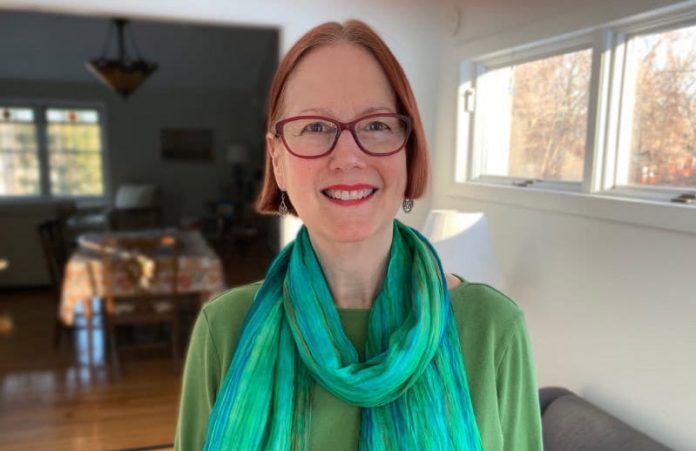
When Paula Gallagher arrived at a rehabilitation center five days after her stroke, she felt overwhelmed and devastated.
She also couldn’t speak. The clot that reached her brain had stolen her voice.
Gallagher, who lives in Madison, Connecticut, was diagnosed with a form of Broca’s aphasia, which meant she could understand what other people said but struggled to speak herself.
She also had apraxia, an inability to control the muscles used to form words.
Upon admittance, she couldn’t speak or write, not even her name, but she could read and understand speech.
And she could still dance.
In her room, the former professional dancer would move through various styles of dance – ballet, modern, belly dancing.
One day, an aide saw her belly dancing. Every shift, that staffer tried to make it to Gallagher’s room so they could belly dance together.
Gallagher spent three weeks at the facility undergoing intensive therapy. When she went home, she could say only a few words. Her first name. Hello.
When she started using “yes” and “no,” she didn’t always use them correctly.
About three months after the stroke, her husband, Bill Johnson, told Gallagher how impressed he was by her dedication to speech therapy.
“What else am I gonna do?” she answered cheerfully.
She’d spoken her first sentence since her ordeal began.
That ordeal began a few days before Christmas 2020. Johnson was awake early and reading downstairs when he heard Gallagher walking back and forth in an upstairs hallway.
He went to check on her and found her looking confused and unable to talk. Johnson immediately suspected a stroke and called 911.
Because of the COVID-19 pandemic, Johnson had to drive his own car behind the ambulance to the hospital 30 minutes away. He then had to wait outside as she was treated in the ER.
Doctors called him to say they found a clot in Gallagher’s middle cerebral artery. They wanted his permission to perform a procedure called a thrombectomy to remove the clot.
“There was a lot of damage, and it can only get worse,” the doctor told him.
“Yes, do it!” Johnson nearly shouted into the phone.
Before the procedure, Johnson was allowed to come see his wife.
“It’s going to be OK,” he told her. “They know what they’re doing.”
Within seconds, he was ushered to the nearest emergency exit, left alone to find the lot where he’d parked his car.
On the way home, he received another call. The clot had been removed and Gallagher had retained movement in all her extremities.
Doctors spent days trying to determine what caused the stroke. Gallagher was fit, ate a healthy diet, hadn’t smoked a cigarette in 35 years, and had no family history of stroke.
They never found a reason, labeling it “cryptogenic,” the term for strokes of unknown origin.
She had, however, been under extreme stress the year leading up to her stroke, including taking care of her dying mother in Florida, relocating from Washington, D.C., and losing family members to COVID-19.
Chronic stress has been shown to be associated with increased cardiovascular events.
After the breakthrough of her first sentence, Gallagher continued making progress.
Now a year later, while she sometimes speaks haltingly and can’t always find the word she needs, she’s able to communicate on a basic level and continues to improve. Writing is still very challenging.
With an occupational therapist, she worked on functional skills such as basic math, counting money and telling time.
“The first time the therapist put a quarter, dime and nickel in my hand, I didn’t know what it was for,” Gallagher said. “We used a lot of flash cards for math and clocks.”
One of her favorite therapy techniques continues to be melodic intonation therapy, which uses singing to improve language.
Chanting nursery rhymes is especially effective, said Gallagher. Two of her favorites are “Peter Peter Pumpkin Eater,” and “Rub-a-Dub-Dub.”
“They help me get more lyrical in my speech,” she said.
As an independent woman who was single until her 50s, the 69-year-old sometimes feels frustrated having to rely on Johnson for so many things.
But she’s also grateful for the support and encouragement. The two have been married for 10 years; both retired in 2018.
Dance and creativity remain an important part of Gallagher’s life. She’s participated in online classes and creates dance-themed collages, as well as poetry. She also hopes to teach sacred dance, something she has been practicing for years.
“Dancing is a good way to express yourself when you can’t talk,” she said. “Dance is my medicine.”
Written by Diane Daniel.
If you care about stroke, please read studies about combo therapy that can cut risk of heart attack and stroke by half, and retired entertainer thought she slept awkwardly. It was a stroke.
For more information about stroke, please see recent studies about supplements that may help prevent heart disease, stroke, and results showing drinking coffee this way can help prevent stroke, heart disease.



